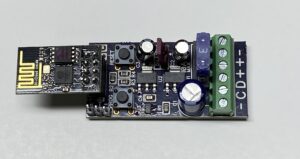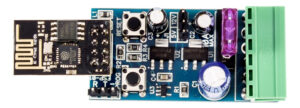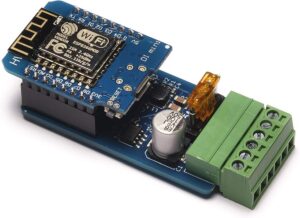If you have been playing with inexpensive sACN/E1.31 pixel controllers then you are most likely familiar with the ESPixelStick firmware and its related hardware. The software is open source and will run on various Esp8266/ESP32 variants. The maker of the software also sells hardware controllers for the software.
There have been several versions of both the firmware and software with a bit of a confusing naming convention. I’ve put together this summary of the boards (along with some additional information) in the hopes it helps clear up some of the confusion…
Hardware Versions


Version 1
- Uses an ESP-01 ESP8266 module with 1 Meg flash memory.
- Has a linear power regulator.
- Supports 680 WS2811 or 63 GECE pixels.
- Supports wired DMX/Renard out if RS-485 driver connected (Serial version of firmware must be used).
- PCB and PCB files available on OSHPARK: (https://oshpark.com/profiles/sporadic)
- Can only run v3.2 firmware: (https://github.com/forkineye/ESPixelStick/releases/tag/v3.2)
- Can run the ESP-01 version of WLED firmware.
More info here: https://forkineye.com/espixelstick-v1/

Version 2
- Uses an ESP-01 ESP8266 module with 1 Meg flash memory
- Has a switching power regulator
- Supports 680 WS2811 or 63 GECE pixels
- Supports wired DMX/Renard out if RS-485 driver connected (Serial version of firmware must be used)
- Build manual with schematic available: (https://forkineye.com/espixelstick-v2-assembly-usage-manual/)
- Can only run v3.2 firmware (https://github.com/forkineye/ESPixelStick/releases/tag/v3.2)
- Can run the ESP-01 version of WLED firmware

Version 3
- WEMOS D1 Mini ESP8266 module with 4 Meg flash memory
- Has a switching power regulator
- Supports 680 WS2811 or 63 GECE pixels
- Includes wired DMX/Renard output driver
- Can run V3.2 or V4.x ( v4.x is beta only) firmware (https://github.com/forkineye/ESPixelStick/releases)
- V4.x firmware supports SD card for show files to run in FPP multisync remote mode
- Can run the ESP8266 version of WLED
More info here: https://forkineye.com/espixelstick-v3/
Software Versions
V3.2
Most current release version of ESPixelStick firmware
Runs on V1/V2/V3 ESP8266 based ESPixelStick hardware
Supports E1.31/sACN input (unicast or multicast)
Supports MQTT
Supports single WS281x & GECE pixel output (600 WS281x pixels or 63 GECE pixels)
Supports Differential Renard & DMX output (requires RS-485 module)
V4.x
Runs on V3 ESP8266 based ESPixelStick hardware & 20 additional ESP8266 and ESP32 based platforms.
Supports E1.31/sACN (unicast or multicast) & DDP input.
Supports MQTT & ALEXA.
V3 HW supports a single output port. The port provides both Pixel outputs and serial outputs with a built in RS-485 compliant differential line driver
Pixel Output(s), all versions: WS281x & GECE.
Optional pixel protocols: APA102, GS8208, TM1814, UCS 1903, UCS 8903, WS2801
Supports one pixel output on V3 hardware (eight pixel outputs & APA102, WS2801 pixel outputs on ESP32)
Supports Serial output (Generic Serial, Renard & DMX) on all outputs (V3 HW has one built-in RS-485 Differential output module), up to 8 serial outputs on ESP32.
Supports 1 Relay output on V3 HW, (8 relay outputs on ESP32).
Supports 16 PWM outputs on ESP32 (requires PCA9685 module).
Supports SD card for local storage of files for FPP/FSEQ support.
Has built in Test effects that can drive all outputs. (Auto disable if input data is detected).
The current V4.x firmware will run on the following modules:
espsv3, (V4 on the V3 HW)
d1_mini,
d1_mini_pro,
d32_pro,
d32_pro_eth,
esp32_cam,
esp32_ttgo_t8,
d1_mini32,
d1_mini32_eth,
esp32_bong69,
esp32_wt32eth01,
esp32_quinled_quad,
esp32_quinled_quad_ae_plus,
esp32_quinled_quad_ae_plus_8,
esp32_quinled_quad_eth,
esp32_quinled_uno,
esp32_quinled_uno_ae_plus,
esp32_quinled_uno_eth,
esp32_quinled_dig_octa,
esp01s, (V4 on the V1/2 HW)
d1_mini_mhetesp32minikit,
olimex_esp32_gw,
d1_mini_twilightlord,
d1_mini_twilightlord_eth,
esp32_devkitc,
esp32_quinled_uno_eth_espsv3, (Quinled processor on V3 HW)
esp32_quinled_uno_espsv3, (Quinled processor on V3 HW)
m5stack_atom,
esp3deuxquatro_dmx,
esp32_wasatch
The V4 .x code in the forkineye GitHub site is quite old. The most current V4.x code is available here :
https://github.com/MartinMueller2003/ESPixelStick/releases/download/dist/dist.zip
Or here:
https://github.com/MartinMueller2003/ESPixelStick/releases/tag/dist
These site are updated by one of the code makers, Martin Mueller and includes binaries for various ESP8266 and ESP32 modules.
ESPixelStick Software: https://github.com/forkineye/ESPixelStick
ESPixelStick Web Site: https://forkineye.com/espixelstick/
There is also the ESPixelStick Software Web Flasher available here:
https://espixelstickwebflasher.from-ct.com:5000/
ESPixelStick vs WLED?
WLED is similar to ESPixelStick in that it allows you to drive pixels using sACN/E1.31 data. In addition WLED supports ArtNet and has a huge amount of built-in effects. While I do love WLEDs wide range of effects and other features, I have found ESPixelStick to be more stable when you just want to streaming sACN/E1.31 data.
Since WLED will run on all versions of the ESPixelStick hardware you can easily install the firmware and try it. The ESPixelStick V1/V2 hardware versions can only run the ESP-01 version of WLED, this version fits on the smaller flash of the ESP-01 and is missing the “over the air” firmware update feature. The ESPixelStick V3 hardware version runs the ESP8266 version of WLED and includes all features.
Other Hardware?
The ESPixelStick firmware is open source and will run on any ESP8266 variant. One of the most convenient is the ESPixelPOPs board which is similar to the ESPixelStick V1 board.
QuinLED makes some ESP32 based boards that support ESPixelStick V4 firmware
DMX Output
All versions of the ESPixelStick firmware can be set to send out DMX or Renard serial data instead of Pixel data. On the V3.2 version of the firmware (used for the V1/V2/V3 boards) you select either the Pixel (for driving pixels) or the Serial (for sending DMX or Renard data out) version of the firmware when flashing the board. On the V4.x version I believe you configure this from a menu once the firmware is loaded.
The V3 version of the hardware has the DMX RS-485 driver built in while on the V1/V2 hardware versions you will need to add a driver. Here are some site with further information on such interfaces:
Other things of note
After uploading the V3.2 firmware on the V1/V2 hardware you must manually reset the ESP-01 module even though the updater says that it has rebooted.
The ESP-01 modules (used in the V1/V2 hardware only have 1 Meg FLASH which limits you from installing the V4.x firmware (or the full version of WLED). If you are willing to try SMD soldering then you can upgrade the ESP-01 FLASH to 4 Meg by replacing the chip. The 4 Meg chips cost very little and it`s not too hard to try:
Due to the lack of GPIO pins on the ESP-01 you won`t get any of the additional hardware features but you will be able to run the latest firmware (though I don`t know if the V4.x firmware has any enhancements that would make it worth your time)
Note that there is now an ESP-01S available that has 4 Megs of flash so that’s an option also
